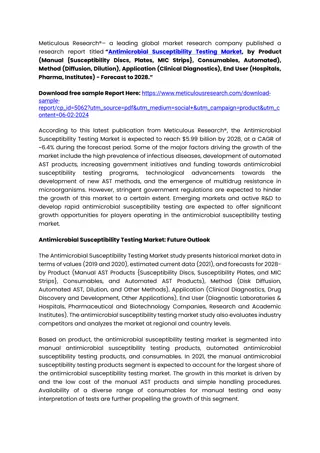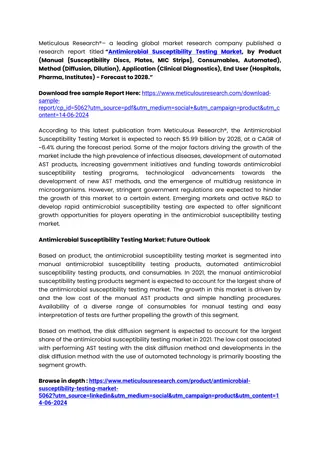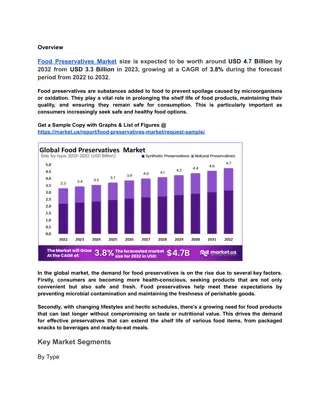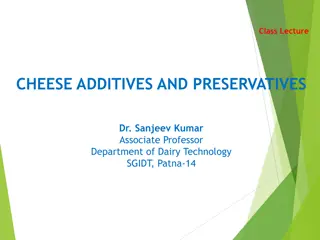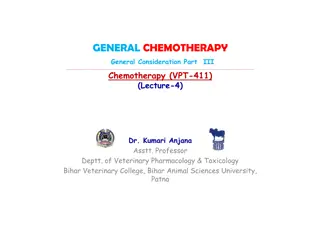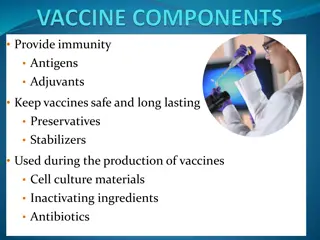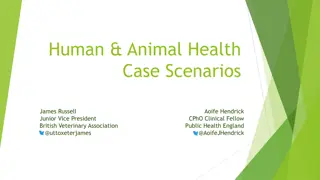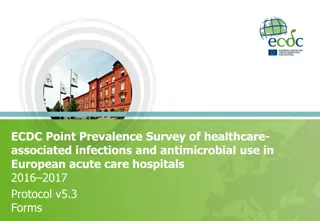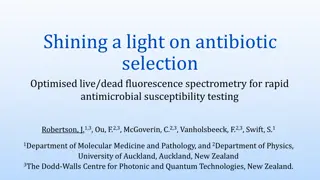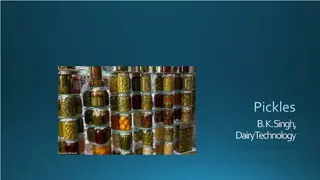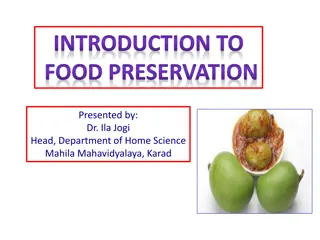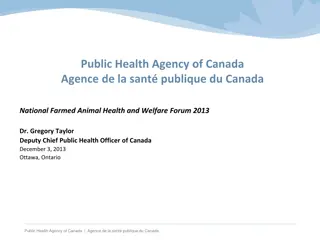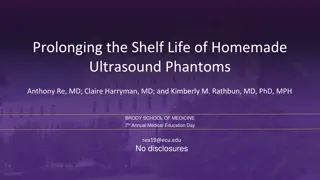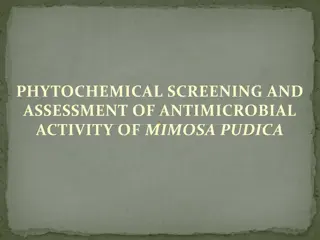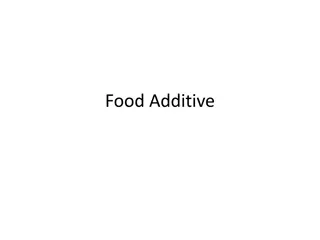Food Preservation with Antimicrobial Preservatives
Food preservation with antimicrobial preservatives involves the use of chemical compounds to prevent or delay food spoilage. These compounds, either naturally present or added during processing, can kill microorganisms or control their growth in foods. Factors for evaluating the suitability of an antimicrobial agent include its spectrum of antimicrobial properties, effects on food quality, regulatory requirements, and economic viability. Common antimicrobial preservatives like benzoic acid, parabens, acetic acid, and lactic acid are used in various food products to inhibit the growth of bacteria, yeasts, and molds.
- Food preservation
- Antimicrobial preservatives
- Chemical compounds
- Microbial growth control
- Food additives
Download Presentation

Please find below an Image/Link to download the presentation.
The content on the website is provided AS IS for your information and personal use only. It may not be sold, licensed, or shared on other websites without obtaining consent from the author. Download presentation by click this link. If you encounter any issues during the download, it is possible that the publisher has removed the file from their server.
E N D
Presentation Transcript
Lec.7 Food Microbiology Dr. JehanAbdul Sattar Food Preservation with antimicrobial preservatives: The use of chemicals to prevent or delay the spoilage of foods derives in part from the fact that such compounds are used in the treatment of diseases of humans, animals, and plants. Many chemical compounds, either present naturally, formed during processing, or legally added as ingredients, can kill microorganisms or control their growth in foods. They are, as a group, designated as preservatives. Some of the naturally occurring preservatives can be present in sufficient amounts in foods to produce antimicrobial action, such as lysozyme in egg white and organic acids in citrus fruits. Some of the antimicrobials can be formed in enough quantities during food processing to control undesirable microbial growth, such as lactic acid in yogurt fermentation. Among the many food additives, some are specifically used to preserve foods against microorganisms (such as NO2in cured meat to control spore germination, especially of Cl. botulinum) whereas others are added to improve the functional properties of a food (such as butylhydroxyanisol, BHA, used as an antioxidant, although it has antimicrobial properties). *IdealAntimicrobial preservatives Several factors need to be considered in evaluating the suitability of an antimicrobial agent as a food preservative, based on: 1 Antimicrobial properties: A compound with a broader antimicrobial spectrum is more suitable for application in foods so that it is effective against many types of microorganisms important in foods ( molds, yeasts, bacteria, and viruses), as compared with one that has a narrow spectrum. Also, a compound effective not only against vegetative cells but also against spores is preferred. Finally, it should not allow development of resistant strains. 2 Suitability for application in a food: Acompound should not only have the desired antimicrobial property but also not affect the normal quality of a food (texture, flavor, or color). It should not interact with food components and become inactive. It should have a high antimicrobial property at the pH, 1
aw, Eh, and storage temperature of the food. It should be stable during the storage of the food. Finally, it should be economical and readily available. 3- Ability to meet regulatory requirements: The regulatory requirements include the effectiveness of an antimicrobial agent in a food system. It should be effective in small conceal poor quality and spoilage of a food. Most importantly, it should be non toxic and safe for human consumption, generally recognized as safe (GRAS). Finally it should be listed in the label, indicating its purpose in the food. concentrations and should not Antimicrobial preservatives added to foods: 1- Acids A- Benzoic acid and parabens Benzoic acid and its sodium salt , The antimicrobial activity of benzoate is related to pH, the greatest activity being at low pH values. Benzoic acid/benzoates are incorporated into margarine, pickles, apple cider, soft drinks, tomato catsup, salad dressings.They are inhibitYeasts and molds. Parabens (Esters of p-Hydroxy benzoic Acid): Parabens are used as methyl, ethyl, butyl, or propyl parabens. They are broad spectrum antimicrobial agents, they are effective at high pH and against bacteria, yeasts, and molds. They are used in fruit fillings, jams and jellies, pickles, confectioneries, salad dressings and mustards. B-AceticAcid Acetic acid is used usually as vinegar (5 to 10% acetic acid) or as salts of sodium and calcium in pickles, salad dressings, and sauces. It is more effective against bacteria than yeasts and molds. C-PropionicAcid Propionic acid is used as salts of calcium and sodium in bread, bakery products, cheeses, jam and jellies, and tomato puree. It is effective against molds and bacteria but almost ineffective against yeasts. 2
D-LacticAcid Lactic acid is used as acid or sodium and potassium salts in carbonated drinks, salad dressings, pickled vegetables, low-heat-processed meat products, and sauces. It is less effective than acetic, propionic, benzoic, or sorbic acids, but more effective than citric acid. It is more effective against bacteria but quite ineffective against yeasts and molds. E-CitricAcid Citric acid is used at 1% (or more) in nonalcoholic drinks, jams and jellies, baking products, cheeses, canned vegetables, and sauces. It is less effective than lactic acid against bacteria as well as yeasts and molds. F-SorbicAcid It is an unsaturated acid and used either as acid or as salts of sodium, potassium, or calcium. It is used in nonalcoholic drinks, some alcoholic drinks, processed fruits and vegetables, dairy desserts, confectioneries, mayonnaise, salad dressings and mustards. It is more effective against molds and yeasts than against bacteria. Among bacteria, catalase-negative (e.g., lactic acid bacteria) are more resistant than catalase-positive species (e.g., aerobes, S. aureus, and Bacillus spp.). Also, aerobic bacteria are more sensitive to it than anaerobic bacteria. 2-Nitrite and Nitrate Curing agents that contain nitrite, and together with NaCl, sugar, spices, ascorbate, and erythorbate, are permitted for use in heat-processed meat, poultry, and fish products to control growth and toxin production by Clostridium botulinum. The antibotulinal effect consists of inhibition of vegetative cell growth and the prevention of germination and growth of spores that survive heat processing or smoking during postprocessing storage. Nitrate and nitrite are also used in several European countries in some cheeses to prevent gas blowing by Cl. butyricum and Cl. tyrobutyricum. In addition to clostridial species, nitrite is inhibitory, to some extent, to Staphylococcus aureus, Escherichia, Pseudomonas, and Enterobacter spp. It also forms desirable product color and enhances flavor in cured meat products. Nitric oxide (NO), the important product from the standpoint of color fixation in cured meats. Nitric oxide reacts with myoglobin under reducing conditions to produce the desirable red pigment nitrosomyoglobin. 3
When nitrite reacts with secondary amines, nitrosamines are formed, and many are known to be carcinogenic. Nitrosamines have been found in cured meat and fish products at low levels. Because of this, there is a trend to reduce NO2or to use other preservatives to control Cl.botulinum in low-heat-processed meat products. 3 Sulfur Dioxide and Sulfites Sulfur dioxide, sodium sulfite (NaSO3) , sodium bisulfide (NaHSO), and sodium metabisulfite (Na2S2O) are used to control microorganisms (and insects) in soft fruits, fruit juices, lemon juices, beverages, wines, sausages, pickles, and fresh shrimp. They are more effective against molds and yeasts than bacteria; among bacteria, the aerobic Gram-negative rods are the most susceptible. The antimicrobial action is produced by the undissociated sulfurous acid that rapidly enters the cell and reacts with the thiol groups in structural proteins, enzymes, and cofactors, as well as with other cellular components. Sulfur dioxide and sulfites are also used as antioxidants in fresh and dried fruits and vegetables (salads) to prevent browning. 4 Salts andSugars These compounds are grouped together because of the similarity in their modes of action in preserving foods by lower the water activity and have an adverse effect on microorganisms. Sodium chloride is used in brines and curing solutions or applied directly to the food. The early food uses of salt were for the purpose of preserving meats. This use is based on the fact that at high concentrations, salt exerts a drying effect on both food and microorganisms. Salt has been reported to have the following effects on microorganisms: 4
1. It causes high osmotic pressure and hence plasmolysis of cells. 2.It dehydrates foods by drawing out and typing up moisture as it dehydrates microbial cells. 3. It ionizes to yield the chlorine ion. 4. It reduces the solubility of oxygen in the moisture 5. It sensitizes the cell against CO2. 6. It interferes with the action of proteolytic enzymes. Sugar such as glucose or sucrose has ability to make water unavailable to organisms by osmotic effect. 5 H2O2 A solution of H2O2is recommended as an antimicrobial agent in raw milk to be used in cheese processing (to control growth of psychrotrophic Gram negatives that produce heat-stable enzymes), liquid egg to facilitate destruction of Salmonella by low-heat pasteurization, packaging material used in aseptic packaging of foods, and food processing equipment. In raw milk and liquid egg, catalase is used before pasteurization to hydrolyze H2O2to water and oxygen. H2O2 is a strong oxidizing agent, and the germicidal action is associated with this property . 6 Epoxides (Ethylene Oxide, Propylene Oxide) Ethylene oxide and propylene oxide are used as fumigants to destroy microorganisms (and insects) in grains, cocoa powder, gums, nuts, dried fruits, spices, and packaging materials. They are germicidal and effective against cells, spores, and viruses. Epoxides are alkylating agents and react with various groups (e.g., SH, NH, and OH) in cellular macromolecules, particularly structural proteins and enzymes. 7 Antibiotics Antibiotics in foods were approved by the Food and Drug Administration (FDA) and approved by the Expert Committee of the World Health Organization (WHO) . These antibiotics include : Tetracyclines to extend the refrigerated shelf life of seafood and poultry . However, because of the possible increase in antibiotic-resistant bacteria, the use of these antibiotics in food was later banned. Natamycin, is an antifungal agent. Its use as a dip or spray to prevent growth of molds and formation of mycotoxins on the surface of some cheeses, sausages, and in raw peanuts. Tylosin, inhibits protein synthesis, is a bactericidal antibiotic that is more effective against Gram- positive than Gram-negative bacteria and also inhibits outgrowth of germinated 5
endospores. Because of its high heat resistance, it has been used in controlling the growth of sporeformers in low-acid canned products. Subtilin is effective in canned foods ,preventing the outgrowth of germinating endospores. 7 Diacetyl Diacetyl is produced by several species of lactic acid bacteria in large amounts, particularly through the metabolismof citrate . It is antibacterial against many Gram-positive and Gram-negative bacteria. The antibacterial action is probably produced by deactivating some important enzymes. 8 Bacteriocins of LacticAcid Bacteria The term bacteriocin is currently used to refer to a group of bioactive peptides produced by many bacterial strains from Gram-positive and Gram-negative groups. The bacteriocins produced by many strains of lactic acid bacteria and some propionic acid bacteria are of special interest in food microbiology because of their bactericidal effect normally to different Gram-positive spoilage and pathogenic bacteria and under stressed conditions to different Gram-negative bacteria important in food. Bacteriocins of lactic acid bacteria are bactericidal to sensitive cells, and death occurs very rapidly at a low concentration. Also using of LAB bacteriocins in combination with other preservative techniques can effectively control spoilage bacteria and other pathogens, and can inhibiting the activities of a wide spectrum of organisms, including resistant Gram-negative bacteria. The bacteriocins most studied for their biopreservative effect in food products, and more specific in meat and meat products, include nisin and pediocins. Nisin is produced by Lactococcus lactis, however, is used in certain canned foods, most often employed in dairy products processed cheeses, condensed milk, pasteurized milk. Because of the effectiveness of nisin in preventing the outgrowth of germinating endospores of Cl.botulinum and this agent has been used as a possible replacement for nitrite in processed meats. Pediocin, produced by Pediococcus acidilactici, have been used successfully to control growth of L. monocytogenes in cottage cheese, half-and-half cream and cheese sauce, raw or fresh meat, cooked meat products and fermented meat products. 9 Spices Many spices, condiments, and plant extracts are known to contain antimicrobial compounds. Some of these include cinnamic aldehyde in cinnamon; eugenol in cloves and cinnamon. Their bacteriostatic and fungistatic properties depend on the active agent. Because of the small amounts used as spices in foods, they 6
probably do not produce any antimicrobial effects. However, the antimicrobial components can be used in higher concentrations as oleoresins or essential oils. The antimicrobial properties of garlic, onion, and ginger, as well as cabbage, brussels sprouts, carrots, and others have generated interest for their possible use as natural preservatives. 10-WoodSmoke Many processed meat products and fishes are processed with smoke generated by burning hardwood. The main reason for smoking meat, fish, and cheese is to impart desirable flavor, texture, and color to the products.The other benefit is the long shelf life of smoked products, especially those exposed to smoke during heating. The smoke contains several different types of chemicals that deposit on the food surface, many of which have antibacterial properties. The most important antibacterial agents are formaldehyde, phenols, and cresols. Depending on the temperature and time of heating, degree of surface drying and the concentrations, smoking can be both bacteriostatic and bactericidal to bacterial cells. Although smoke has a slight antifungal action, it does not have any adverse effects on the survival or germination of bacterial spores. Smoke also contains some chemicals that are carcinogenic, such as benzopyrene and dibenzanthracene. *Biopreservation Biopreservation or biological preservation can be defined as a preservation method to improve safety and stability of food products in a natural way by using desired microorganisms (cultures) and/or their metabolites without changing the sensory quality. Cultures can be defined as protective or antagonistic micro- organisms that are added to a food product only to inhibit pathogens and/or to extend the shelf-life, while changing the sensory properties of the product as little as possible. These cultures differ from starter cultures in their functional objectives. Starter cultures are used in food fermentations in order to modify the raw material to give it new sensory properties and this relying on the metabolic activity (acid production) of the culture, (antimicrobial action) is of secondary importance. while the preservation effect Biopreservation can be applied in food products by two basic methods: 1- Adding crude, semi-purified or purified microbial metabolites; 2- Adding pure and viable micro-organisms. 7
Lactic acid bacteria have antagonistic properties which make them particularly useful as biopreservatives. Beneficial bacteria or the fermentation products produced by these bacteria are used in biopreservation to control spoilage and pathogens in food. There are a various modes of action through which LAB can interfere with the growth of others such as organic acid, hydrogen peroxide, Diacetyl, bacteriocins production, etc. 8




